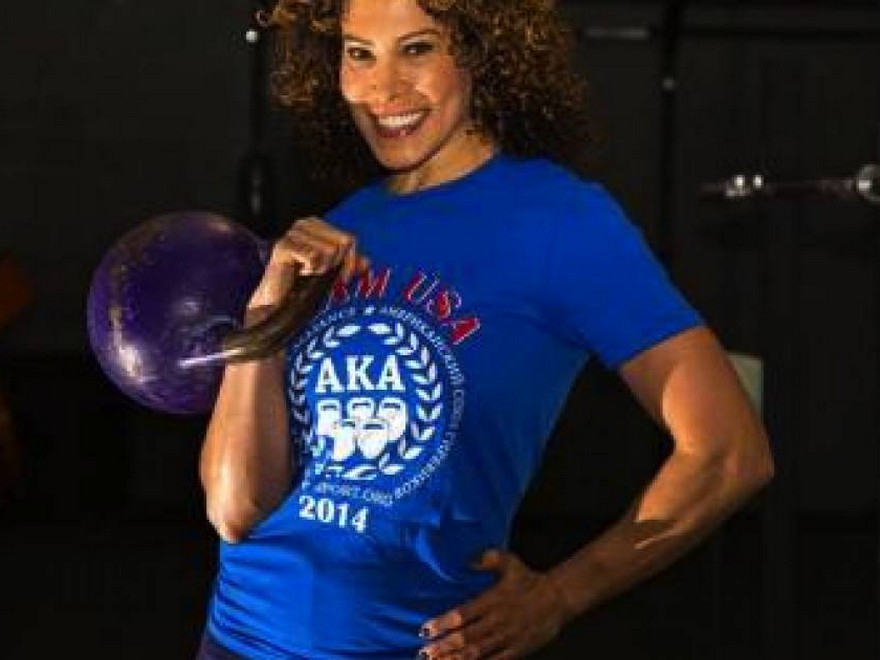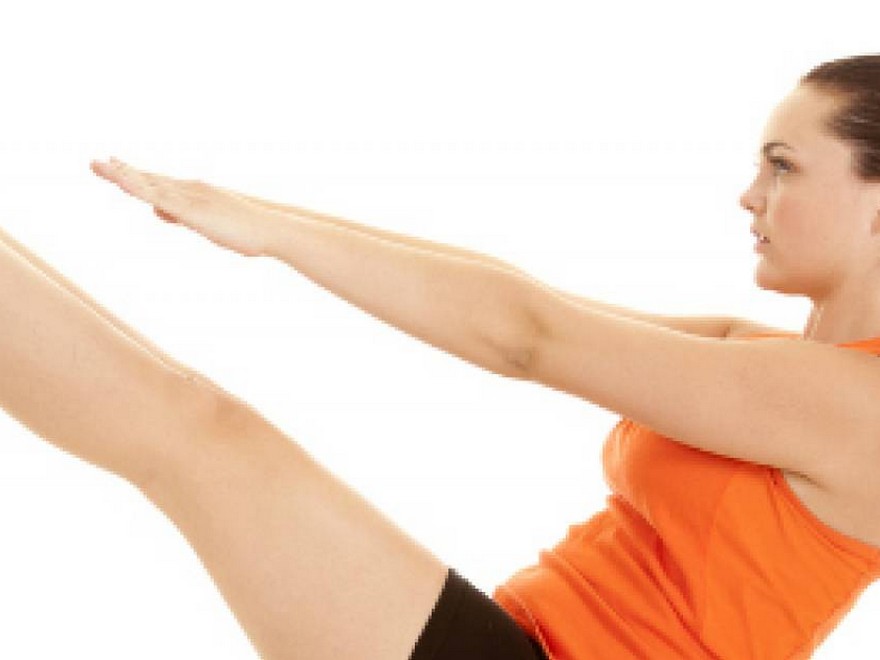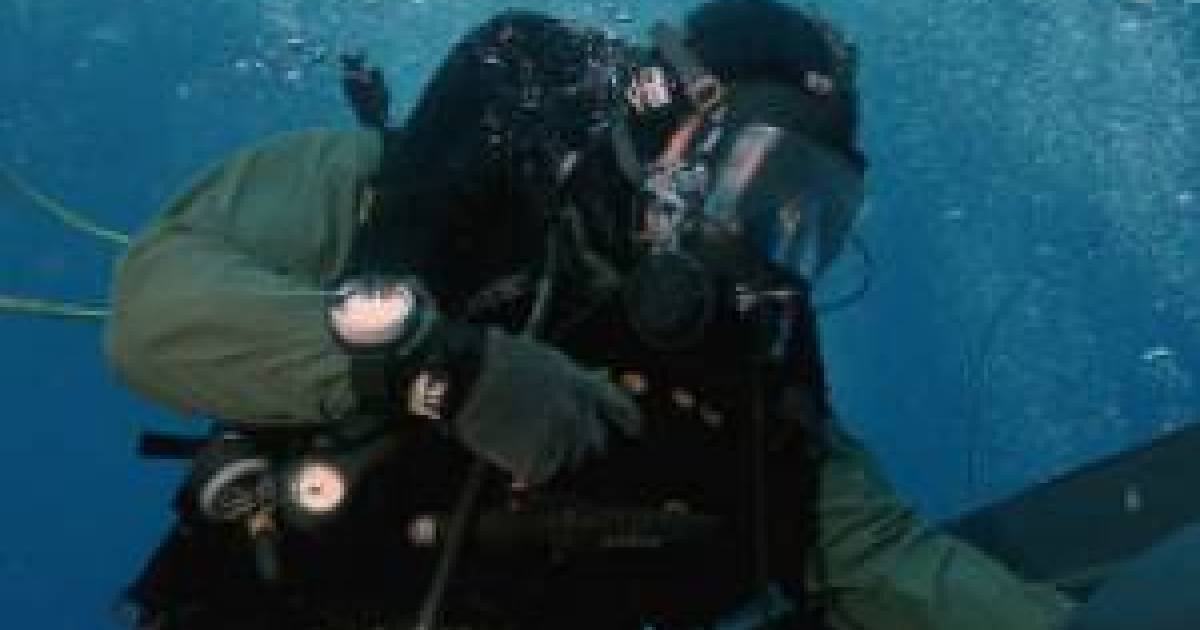4 Weeks of Girevoy Sport Training: Do You Have What It Takes?

Kettlebell sport, also known as girevoy sport (GS), is a highly challenging power-endurance feat of a cyclical nature. Lifters’ success involves technique, flexibility, strength and power, proper breathing patterns, aerobic capacity, stability, and mental focus.
As opposed to Olympic lifting or powerlifting, GS requires an athlete to lift a sub-maximal load, completing as many repetitions as possible in ten minutes.

That's me competing in GS.
History of Girevoy Sport
The Russians can take credit for developing this unique form of competition, yet weights with handles have been used as early as 8th century BC, when the Greeks began creating their own versions of gymnasiums and were the first to develop organized approaches to weight training and sports, including the use of halteres.
Halteres, from the Greek allomai, means "leap” or “spring.” These metal or stone weights with holes were used for lifting as well as for assisting athletes in the long jump. By holding one in each hand, halteres, weighing between 12 and 35kg, allowed an athlete greater jumping distance.

Greek halteres weighed between 12 and 35kg.
The 3 Traditional Lifts of Girevoy Sport
Lifters choose the weight and lift they wish to perform at competition, usually months in advance. They then train to show quality reps and fulfill ten minutes in their chosen lift.
Biathlon: Jerk and Snatch
Ten minutes of jerk is followed by ten minutes of snatch, with a minimum thirty-minute rest between the two lifts. For jerk, men use two bells, while women typically use one, changing sides once. These two ten-minute events are very challenging to perform and prepare for, therefore biathlon is not ideal for beginners.
To do the jerk, the lifter swing cleans the kettlebells to the tack position with the elbows resting on the iliac crests. From the rack, the lifter quickly dips the legs from the knees as in a hinge. There is no change in the position of the arms or bells during this first dip.
"Ten minutes of jerk is followed by ten minutes of snatch, with a minimum thirty-minute rest between the two lifts."
The next movement, the drive, accelerates the bells off the body with a fast straightening of the legs. The lifter then quickly bends his/her knees so they are under the arm and bell(s) by the time they straighten. The lifter then straightens the legs with the arm still straight and bell(s) fixated. Once this is done, the lifter can let the bell(s) drop back to the rack position.
For the snatch portion of the biathlon, both men and women use one bell, changing sides once. The lifter begins the snatch from the floor with a backward swing, then accelerates it forward and up. Just before the bell reaches the overhead position of fixation, the lifter slips his or her hand into the handle. The bell is then fixated overhead with knees and arm straight. On the downswing, the bell is rotated slightly to reduce its momentum and caught before it passes between the legs.
Long Cycle
This format offers a slower pace than the jerk or snatch due to the double movement of the cycle – one swing clean to rack position, followed by one jerk. The bell is then brought down through the rack to the next swing clean. Men use two bells, while women typically use one, changing sides once.
An example of long cycle from a competition in 2010.
Weights Used in GS Competition
At certain meets, the weights lifted are determined by the host organization. For example, to win the pro division at international meets, men lift 32kg/72lb and women 24kg/53lb.
Meets in the United States have become very enticing as women can compete with bells as light as 8kg/17.5lb and men with 16kg/35lb. This enables novice lifters to build on their technique and endurance while enjoying the experience of competing and achieving ranks.
Colors Representing GS Weights:
- Pink – 8kg
- Blue – 12kg
- Yellow – 16kg
- Purple – 20kg
- Green – 24kg
- Red – 32kg
Can Anyone Compete?
There are no age restrictions in GS. I’ve seen ages five through 75 on the platform – and it’s a beautiful and inspiring sight! Some meets do require qualification via video submission prior to competition, while others do not.
"There are no age restrictions in GS. I’ve seen ages five through 75 on the platform – and it’s a beautiful and inspiring sight!"
Regardless of the competition, it is highly advisable that you use a good coach throughout your training and competition process. A coach is necessary to guide you in the many aspects of the sport – breathing patterns, pacing, execution of lifts, hand positions, hand care, specific assistance drills to overcome weaknesses, recovery, mental preparation and much more.
Competing in GS doesn’t mean you have to give up everything else, either. If you enjoy activities like lifting, running, cycling, rowing, or swimming, you can utilize them to further develop the aerobic capacity necessary for GS.

Earning Medals and Ranks
In GS, lifters have the opportunity to win gold, silver, or bronze medals in their weight class, age class, and the overall by putting up the most reps in any of these categories, and using the same weight as other lifters in the same category.
Ranks are awarded when a lifter fulfills a certain number of reps dictated by their weight class. Rank abbreviations are:
- HMS – Honored Master of Sport
- MSIC – Master of Sport International Class
- MS – Master of Sport
- CMS – Candidate for Master of Sport
- Rank 1, 2, 3
Honored Master of Sport is awarded through the Russian Sport Consulate to only a handful of athletes who have accumulated 150 points through the following prestigious meets:
- Cup of Russia
- European Cup
- European Championship
- World Cups
For example, winning first place in Cup of Russia earns the lifter ten points, but winning first place in European Championship earns 35 points.
Those outside of Russia desiring to earn the title of World Champion should look to compete at either the IGSF or IUKL World Championships. Each organization has its own ranking tables detailing different weight and age categories.
A Sport to Grow Young With
The incidence of injury in GS is very low when compared to other sports. GS involves standing in one place while moving the weights overhead through the use of the legs, spine, abs, and shoulders. The process of training results in increased lean muscle, fat loss, reduced risk of osteoporosis, aerobic conditioning and endurance, and a balanced muscular system. GS training utilizes three dimensions of the joints, flexibility, muscular symmetry, and joint stability. Since GS is a power endurance sport, it creates bodies that are, in most cases, lean and strong.

What Training Entails
Within a training week, lifters will perform:
- Their competition lifts in various timed sets, with varied weights
- Assisted drills to improve flexibility, timing, grip strength, and tempo and breathing patterns
- Full-body resistance training
- Flexibility training
- Cardiovascular exercise in the form of running, swimming, biking, rowing, skating, etc. at various intensities
Training sessions are performed an average of four days per week, with each session lasting approximately ninety minutes to two hours in order to build stability, endurance, conditioning and mental focus.
"The process of training results in increased lean muscle, fat loss, reduced risk of osteoporosis, aerobic conditioning and endurance, and a balanced muscular system."
It is imperative for lifters to have a clock available at all training sessions in order to perform the required reps for each training day. After a couple years of training, lifters will be able to perform the competition pace they’ve trained for without reliance on a clock, but the majority of competitions will still have visible clocks and rep counters for competitors to view while on the platform.
Are You Ready?
So, are you ready to get started on your GS training adventure? I’ve created a four-week program for you to get a taste of the sport.
When you begin training for GS competition, you and your coach will determine which lift(s) you’ll perform. Typically, lifters begin with long cycle since it is a slower pace than jerk or snatch and because snatch is heavily reliant on grip endurance, which takes time to acquire.
The following program is a sample of one week’s training for each lift in order to practice prior to setting up your personalized competition program. For best results, you’ll need a variety of competition bells available. Cardio and conditioning should follow at least three of the four training days.
Girevoy Sport 4-Week Program: Week One
Week 1: Accessory Drills
- Women typically use one bell, men use two
- Practice with mid-range weight to begin – women 12-16kg, men 20-24kg
Monday
Set 1
Rack Walk
Men:
- 90 sec – 2 min
- Rest 1 min
- 3 sets
Women:
- 1 min per side using single bell
- Rest 1 min
- 3 sets
Set 2
Single Arm Swings
- Use “buoyant” knees as bell goes through legs
- 15-20 per arm
- Rest 1 min
- 3 sets
Set 3
Men: Double Arm Swing Clean
- Layer handles and hands right away into rack
- 12-15 reps
- Rest 1m
- 3 sets
Women: Single Arm Swing Clean
- Shift hip over to catch the arm and bell into rack
- 10-15 per arm
- Rest 1m
- 3 sets
Wednesday
Set 1
Men: Double Arm First Dip
- Keep arms attached to trunk and hinging at knees
- 20 reps
- Rest 1m
- 3 sets
Women: Single Arm First Dip
- Keep arms attached to trunk and hinging at knees
- 20 each side
- Rest 1m
- 3 sets
Set 2
Men: Double Arm Jerk
- Expand upper back and keep arms attached to trunk on first dip. Path of arms and bells is straight up and straight down to rack.
- 10-12 reps
- Rest 1 min
- 2 sets
Women: Single Arm Jerk
- Rest arm and bell at hip in rack
- 15 each arm
- Rest 1 min
- 2 sets
Thursday
Set 1
Snatch
- Open hand at head height to slip into handle in overhead fixation
- Catch handle low and follow into backswing
- Men: 15-20 each arm
- Rest 1 min
- 2-3 sets
Women:
- Open hand at head height to slip into handle in overhead fixation
- Catch handle low and follow into backswing
- 12-15 each arm
- Rest 1m
- 2-3 sets
Saturday
Set 1
Long Cycle 5 Second Holds in Each Position
- This drill can be performed for jerk, snatch or long cycle
- Men: 5 min total time
- Women: 5 min total time, 2:30 min each arm
Click on the number below that corresponds to the week of training you're in.
- 1
- 2
- 3
- 4
- >




